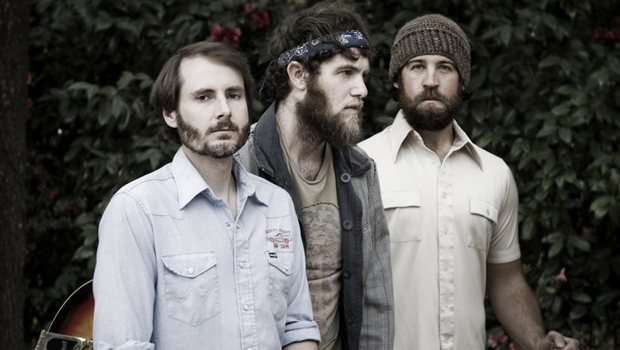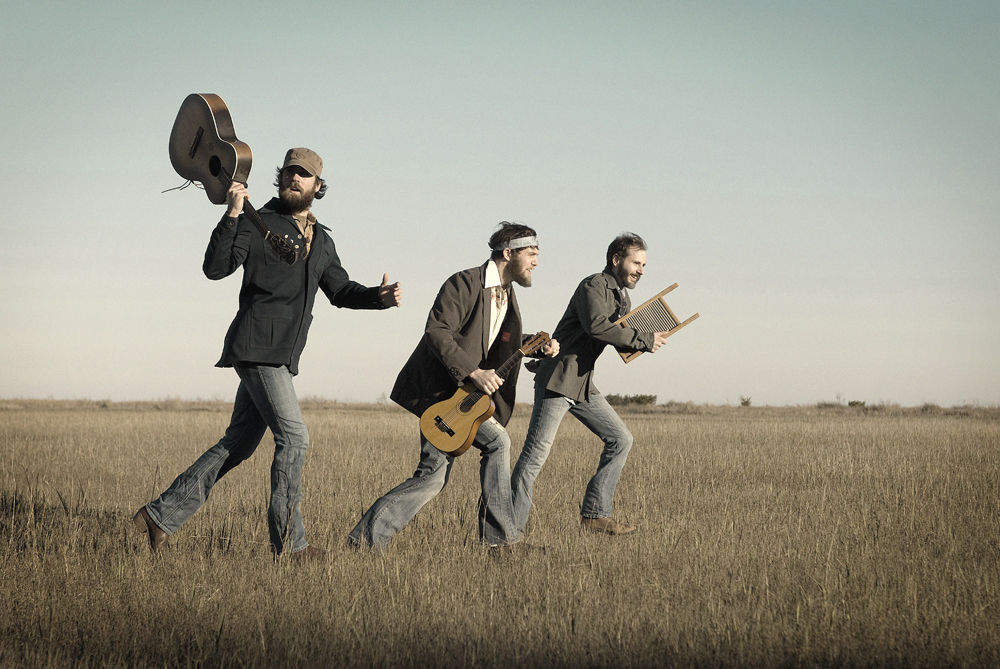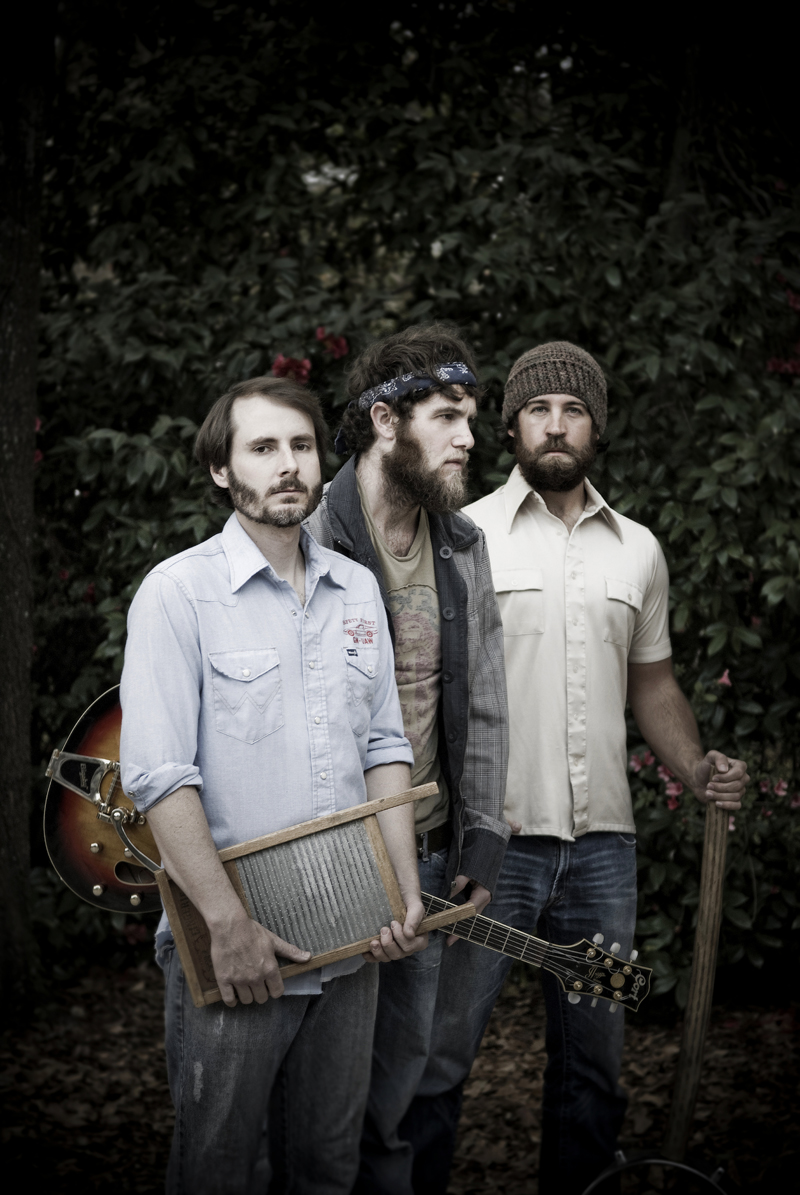Interview: Dan Lotti and Mike Sivilli of Dangermuffin

A strange name and beards that would put lumberjacks' facial hair to shame make Dangermuffin a tough band to ignore, but their unique lineup and genre-blending approach to roots music is what has ultimately earned this South Carolina trio its loyal fan base.
By foregoing a bassist and including only an acoustic guitarist, an electric guitarist and a drummer, singer Dan Lotti feels more freedom to explore the members’ diverse genres of expertise.
“We feel like it’s minimalism, and in our situation it works really well,” Lotti says. “Some people don’t like it, but I think it’s usually just bass players looking for work.”
We caught up with Lotti -- who also plays acoustic guitar -- and electric guitarist Mike Sivilli to talk about minimalism, their approach to covers and being labeled a jam band.
GUITAR WORLD: What inspired you to start playing guitar?
DAN LOTTI: For me, it was the grunge era. Eddie Vedder, Nirvana and a lot of that kind of rock ’n’ roll was what really inspired me to first play. I listened to a lot of Jimi Hendrix when I was younger, too. I actually started out playing electric guitar. I think my first was a Mexican-made Stratocaster. I was in a grunge band and I used to try to break the guitar onstage at the local club we used to play.
MIKE SIVILLI: My roommate in college had this little three-quarter-scale acoustic with one nylon string and four steel strings on it. I used to just sit down and pick on it, and he ended up giving it to me. Then, when I was working for this moving company, I found this really old guitar from the ’60s and this amp, and I asked the guy how much he’d want to sell it for and he just gave them both to me. It was a brand called Global, which I think was a cheap Sears brand or something. It was an SG copy with a Bigsby on it. I would take it home and play along to Sublime albums and classic rock like Lynyrd Skynyrd and stuff. My dad also had an old acoustic in the closet that I never saw him play, but he took it out one time and showed me some bluegrass.
Get The Pick Newsletter
All the latest guitar news, interviews, lessons, reviews, deals and more, direct to your inbox!
You have a pretty unique setup, considering there isn’t a bass player. How did this come to be, and how do you manage to fill all the space?
DL: I got my start as a solo acoustic guitarist, so playing in the bars four or five nights a week, I got used to covering a lot of ground by myself. I had this live Martin Sexton CD where it was just him and a drummer with no bassist, and he was still holding it down. I thought that was just the coolest thing ever. So when we started out, I thought to myself, “Hey, I can hold this thing down.” When we started playing with a drummer, it just seemed to make sense.
What are the advantages of this setup?
DL: Well, there’s no room in the van for a bass player — there’s too much shit in there as it is. But seriously, it’s kind of our unique thing. We’ve tried to play music with some great bassists in town, and it just seems like we lose our fingerprint. When we start bringing in other instruments, like a bass, or we’ve tried keys, it just changes everything up.
How do you compare your approaches to the guitar?
MS: Very opposite. It’s minimalism and maximalism. Generically speaking, it’s just rhythm guitar and lead guitar, but it works. When Dan’s singing, I’ll either be playing rhythm or some kind of call-and-response thing. When he’s not singing, I’m probably playing some kind of melodic thing or some kind of solo, because there isn’t really any other member of the band to take that over. You can’t take any time off. Everything you play plays a very important role in every song, because you’re 33 percent of the song.
DL: When it’s time for Mike to step up and take a solo, it’s great to be able to get behind that rhythmically. Our live shows generally have a pretty standard arrangement, but sometimes it opens itself up and you can take it in any number of directions. Those are usually the best performances for us. It’s great for me as an acoustic guitarist and a rhythm guy to be able to drive the song with Steven while Mike’s soloing. That’s a really big part of what Dangermuffin is. We all enjoy the hell out of it.
Mike, you have a pretty extensive pedal board. What’s your outlook on using effects?
MS: Actually, most of the pedals on my board are just overdrives and distortions that kind of change the color of the amp and the response of it. It just makes you feel like playing in a different way. While the casual listener isn’t going to hear the difference between any of them, it’s more of a feel thing. It’s the way it makes you feel when you’re playing it. It takes on different personalities. My setup looks pretty fancy, but it’s really pretty simple. It’s just a bunch of different flavors of overdrive and distortion, and then a delay and a tuner, and that’s about it. I’ve definitely almost fallen down onstage a few times because I was trying to kick my pedal. If I have a bunch of things on and I need to kick off more than one, it can take a lot of brainpower. But it’s a small price to pay to have that kind of flexibility.
Improvisation seems to be a big part of Dangermuffin’s live shows. How would you describe your approach to jamming?
DL: We come from these eclectic backgrounds, and we want to play it all. We just enjoy playing all those different genres. We’ll do anything from bluegrass, to reggae, to punk to straight-up rock tunes, but there’s always a laid-back, roots-rock approach. I think that’s why we get grouped in with the jam-band scene a good bit. Jam bands are very eclectic. I think we’re jam-friendly, but I don’t think we’re a jam band per se. Mike is the only soloist we have, and a lot of our shows are very song-driven, which is more along the lines of folk music and Americana. We usually just say we’re roots rock, and that kind of covers everything.
Do you have an aversion to being called a jam band?
DL: Not at all. One thing that you find is that there’s a community of music lovers involved with jam bands. Any band that’s trying to make something for itself is just looking for community. They want to find that great venue or that group of people that supports them. I don’t think there’s anything wrong with being called a jam band. The people are music lovers and appreciate what we’re doing, so we’re honored to be a part of that.
How do you bring so many different musical styles together and still maintain a recognizable sound?
DL: I think it has to do with our instrumentation, honestly. If we had other instruments or different musicians, it might sound contrived. Since it’s just the three of us with no bassist, we can keep our fingerprint on any genre. We just enjoy playing different things, and we can kind of weave in and out of genres. It keeps it interesting for us and for the audience, too.
What is the songwriting process like between you two?
MS: It depends. I think everybody has ideas. A lot of times I’ll write riffs, but I don’t write lyrics or whole song ideas. I’ll just have parts. I’ll bring that stuff to the band and let it come together.
DL: For example, the song “Big Suit” was born from Mike’s riff, and then we worked out some other parts together. Then when Steven comes in on it, there are different tempos and different grooves. Some of it works, and some of it doesn’t, and you have to know when to let that go. We’re still learning when to let go of something that’s not working and when to stick with something that could work. Dangermuffin writes all the songs, though. Even if I’m writing the lyrics, it’s all three of us.
MS: Yeah, I’ll never be sitting around with a song and have all the lyrics and say, “Alright, Dan, sing this. Steven, play this.”
You always choose interesting covers and really make them your own. What kind of thought process goes into this?
DL: We actually ripped off Dub Side of the Moon for our Pink Floyd cover. (Easy Star All-Stars) already did a reggae version of “Breathe.” But Mike and I have been playing a lot of the stuff like “Breathe,” “Scarlet Begonias” and our Seal cover, “Crazy,” since we started doing acoustic gigs together in 2005. A lot of those songs have just found their voices over the years. We do some other ones that we don’t play quite as much, but they don’t have the same voice as the others.
I always thought “Crazy” was a unique cover choice for you, but it works really well.
DL: It just starts with a great song. And the message there is just good shit. Plus, I mean, he’s married to Heidi Klum, so you know he’s doing something right.
What kind of advice do you have for new guitar players?
MS: Don’t get discouraged. There’s no such thing as too much practice. You have to get over that physical hump of hurting your fingers and playing simple chords before you can play Jimi Hendrix licks. You just have to. Don’t get discouraged with the learning curve, because you’re not going to be able to pick it up and play what everybody wants to play.
DL: If you love to play music, then just do it. Play as much as you can. Take as many gigs as you can, and you get better with every day. I think that people get the wrong idea when people go into it thinking they’re going to be the next big thing or wonder how they can achieve success. I think that’s the wrong way to go about it, and you put a lot of pressure on yourself. It really stifles your creativity. Being an artist and being creative works best when there is no expectation for what you’re doing. That way you can create freely. Just play, because that’s what’s going to bring you the joy in the end, anyway. It’s not about anything else but expressing yourself through art. That’s why we do it, and that’s what keeps us going.



“The rest of the world didn't know that the world's greatest guitarist was playing a weekend gig at this place in Chelmsford”: The Aristocrats' Bryan Beller recalls the moment he met Guthrie Govan and formed a new kind of supergroup
“We hadn’t really rehearsed. As we were walking to the stage, he said, ‘Hang on, boys!’ And he went in the corner and vomited”: Assembled on 24 hours' notice, this John Lennon-led, motley crew supergroup marked the beginning of the end of the Beatles









